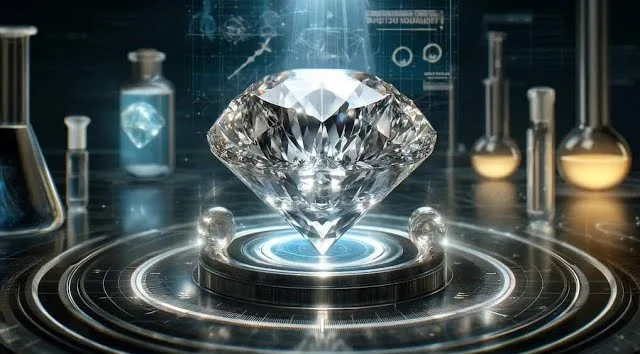South Korean researchers develop a rapid diamond synthesis technique without high pressure or starter stones
In a groundbreaking advancement, researchers in South Korea have developed a technique to grow artificial diamonds in just 15 minutes. This new method bypasses traditional requirements such as high atmospheric pressure or starter stones, marking a significant shift in diamond manufacturing.
Natural diamonds take over three billion years to form under extreme conditions deep within the Earth. They require pressures 50,000 times higher than sea level and temperatures soaring above 1,500°C. Extracting these diamonds involves mining through the Earth’s 2,900 km-thick mantle, a process spanning up to 3.3 billion years from formation to extraction.
The new technique could transform the industry, which has seen significant growth in lab-grown diamonds. According to CNN, 17% of all diamonds on the global market are lab-grown, with the industry’s value skyrocketing from $1 billion in 2016 to over $12 billion in 2022.
Traditionally, labs synthesize diamonds by mimicking the natural conditions in which they form. This process, known as high-pressure and high-temperature (HPHT), involves placing a small starter diamond in a chamber and introducing liquid metal with dissolved carbon. The carbon separates from the metal and gathers around the seed diamond, forming a new diamond. HPHT accounts for about 99% of all lab-grown diamonds but is limited by the difficulty of maintaining extreme conditions and the time it takes to grow a diamond as big as a wooden match head.
Even other fabrication methods, like chemical vapor deposition, require a seed diamond to initiate the process. However, the new technique developed by Rodney Ruoff, a physical chemist at the Institute for Basic Science in South Korea, eliminates this necessity.
Published in the journal Nature on April 24, the team’s findings detail a nine-litre chamber filled with gallium, an element that liquefies at just 30°C. When activated, the chamber produces diamonds within 15 minutes. The researchers experimented with various metal and gas combinations to find the most efficient catalyst. They discovered that a mixture of gallium, nickel, iron, and silicon provided the best results. The silicon appears to act as a seed for crystallization, with carbon depositing onto it from catalytically-produced methane gas.
This technique uses a lower temperature of only 1,025°C, significantly less than HPHT or any other known diamond-growing method, and requires no added atmospheric pressure. The only limitation is that it can currently only produce tiny stones, much smaller than those created by HPHT.
While the new stones are too small for commercial use, such as jewellery, the implications for future applications are substantial. Ruoff’s research, which began over a decade ago, demonstrates the potential for rapid progress in diamond synthesis. “Growth of diamond in liquid metal at moderate temperature and 1 atm pressure opens many possibilities,” the study states.
This breakthrough could eventually lead to the production of larger diamonds, challenging the traditional diamond mining industry and opening new avenues for the use of diamonds in various fields, including technology and manufacturing.
Analysis:
This new diamond synthesis technique has significant implications across multiple dimensions, particularly economic, technological, and environmental. Economically, the rapid and cost-effective production of diamonds could disrupt the traditional diamond market. The current reliance on mining and the high costs associated with it might diminish as more efficient methods become viable. This could lead to a decrease in diamond prices and an increase in accessibility, impacting both the jewelry market and industrial applications where diamonds are used for their hardness and thermal conductivity.
Technologically, this breakthrough can pave the way for advancements in various industries. Diamonds are valuable in the tech industry for their use in semiconductors and high-performance electronics due to their excellent thermal conductivity and electrical insulation properties. With a faster and potentially cheaper production method, we could see an acceleration in the development of diamond-based technologies.
Environmentally, this technique offers a more sustainable alternative to traditional diamond mining, which is known for its significant ecological footprint. Diamond mining can lead to habitat destruction, soil erosion, and water pollution. By reducing the need for mining, this method could mitigate some of these environmental impacts. However, the energy consumption of the new synthesis process must be evaluated to ensure its overall sustainability.
From a sociological perspective, the availability of lab-grown diamonds might shift societal perceptions and values associated with diamonds. Traditionally seen as symbols of luxury and status, lab-grown diamonds could democratize access to these gemstones, altering their cultural significance. This shift might also impact the ethical considerations surrounding diamond purchasing, as consumers increasingly seek conflict-free and environmentally friendly options.
The new technique also holds promise for further scientific research and innovation. The ability to produce diamonds quickly and at lower temperatures can spur new studies in material science, potentially leading to the discovery of novel applications and materials. Moreover, the use of gallium as a catalyst in the diamond-growing process could inspire similar approaches in synthesizing other valuable materials.
Overall, this breakthrough represents a significant step forward in diamond synthesis, with far-reaching implications for the economy, technology, environment, and society. As researchers continue to refine and scale this technique, we may witness a transformation in how diamonds are produced and utilized, heralding a new era of innovation and sustainability.
